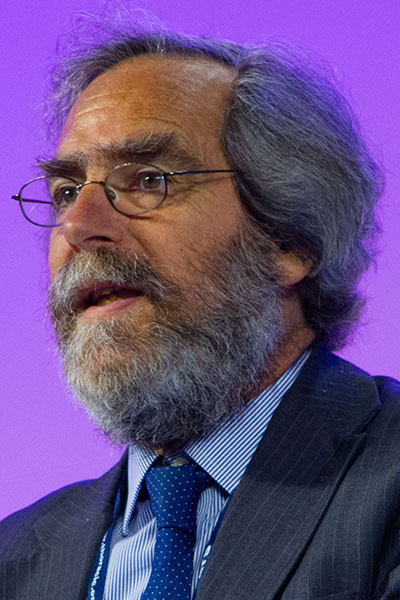Delivering the Monday Keynote Address for the ATS 2025 International Conference, Eric Alton, MD, compared the next wave of advancement in the treatment of cystic fibrosis (CF) to a fundamental football (soccer) strategy—shots on goal.

It’s a concept he learned from Robert J. Beall, the former director of the Cystic Fibrosis Foundation, who gathered researchers approximately 15 years ago and told them that just as a football team’s chances to score are improved by increasing its shots on the goal, so too are the chances for a significant advancement in the treatment of CF improved by multiple, parallel studies, trials, and approaches.
“How exciting it is to see 15 different shots on goal at the moment,” said Dr. Alton, professor of gene therapy and respiratory medicine at the National Heart & Lung Institute, Imperial College London, an NIHR senior investigator, and lead of the UK Respiratory Gene Therapy Consortium (GTC).
In these roles, Dr. Alton has taken several notable shots on goal, focusing for more than a decade on gene therapy treatments for CF, and most recently on the optimization of a lentiviral vector platform pseudotyped with the Sendai virus F and HN envelope proteins (rSIV.F/HN) for lung delivery.
He said his work and others have not yet hit the game-winning goal, but that they are in “a really exciting time” that includes expanded human trials and possible crossover applications, such as treating infants with protein surfactant deficiencies.
The Challenge of CF
CF is a hereditary disease caused by mutations in the cystic fibrosis transmembrane conductance regulator (CFTR) gene, which progresses in severity over time and affects more than 100,000 people globally.
Dr. Alton characterized it as one of the most common lethal inherited diseases because approximately one in 20 people will be recessive carriers of the CF gene, with one healthy copy and one mutated copy. This means that the disease has, approximately, a one in 2,000 chance of manifesting in offspring of couples who both carry a mutated copy.
CFTR modulator therapies have improved conditions for patients with select defined mutations. Unfortunately, Dr. Alton noted, roughly 10 percent of patients are not responsive to this therapy due to mutations or other factors, and another five to 15 percent are intolerant of the treatment.
The Lentiviral Approach
Working through the GTC, Dr. Alton and his colleagues have focused on developing lentiviral vectors that can offer a comparable prospect for a safe and highly efficient treatment of gene expression with the ability to integrate genetic material into the host genome. This would mean increased durability and enable treatments to be redosed.
Their approach involves combining the effective functioning of the lentivirus with the proven bonding capacity of the Sendai virus, resulting in the rSIV.F/HN lentivirus for treatment.
This year, Dr. Alton and his colleagues at the GTC began the LENTICLAIR 1 Phase 1/2 gene therapy trial, focusing on improving lung function outcomes of CF patients regardless of gene mutations.
In Phase 1, patients in the UK and the EU will be administered varying doses for analysis and to optimize doses for Phase 2. Once Phase 2 commences, patients from the U.S. will be added, and groups will include a subset who receive a placebo, a medium dose, and a high dose. Trial participants will then take part in a 15-year follow-up study to monitor safety and efficacy.
Dr. Alton compared the initial aims of this approach to the flight of the Kitty Hawk by the Wright brothers in 1903.
“That plane didn’t fly every day, and when it flew, it flew 50 yards, but it proved the concept that powered flight can happen,” he said. “We explain to our trial participants and our funders that our most optimistic hope for this Phase 2B trial would be, for the first time, to show that the repeated application of gene therapy can make a difference to lung function.”
Prospective Translations
Dr. Alton noted that as these trials develop, new possibilities open. From his work, he sees the potential to improve treatments for infants with protein surfactant deficiencies (an approach that has shown promising results in mouse models), as well as applicable knowledge for the treatment of Alpha-1 antitrypsin (AAT) deficiency, when a protein misfolds and leads to potential liver and lung disease, including emphysema, which has also shown success with mouse models.
“Of course, we’re not the only game in town,” said Dr. Alton. He drew on resources from the National Cystic Fibrosis Foundation to outline an assortment of CF drugs and treatments in development.
The primary challenge each of these studies face relate to issues of cost and questions about whether patients can cross-enroll in various trials, but the number of studies is “really exciting,” Dr. Alton said, noting the range of approaches that includes mRNA splicing corrections, phage gene additions, and gene writing, among others.
Extend Your Learning Beyond San Francisco with ATS 2025 Conference Highlights

With so many valuable educational opportunities offered during the ATS 2025 International Conference, attendees are often forced to decide which sessions to prioritize. That’s why the Society is offering three ATS 2025 Conference Highlights packages for those unable to attend ATS 2025 San Francisco or attendees interested in continuing their education after the conference. Check out the packages and pick the one that’s right for you. Learn at your own pace, whenever and wherever you are!

